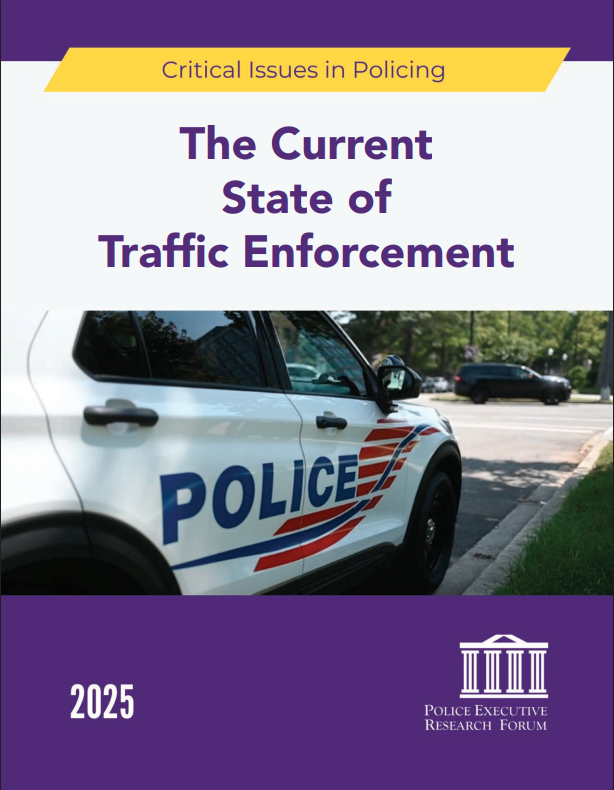|
November 22, 2025 New PERF report asks what can be done to reverse the increase in traffic fatalities
PERF members, This week, the Washington Post reported that between 2010 and 2023, the number of “yearly deaths caused by cars and trucks striking pedestrians rose by 70 percent.” According to the Post, “Wide roadsand fast-moving vehicles — especially when combined with signs of poverty, homelessness, drug and alcohol abuse, and a lack of pedestrian-focused roadway improvements — produced a pattern of death-by-vehicle that is uniquely American.” PERF heard a similar story in March of this year, when it gathered more than 100 police leaders, traffic safety officials, and scholars representing more than 50 local, state, federal, and international law enforcement agencies and organizations, including the National Highway Traffic Safety Administration (NHTSA), Johns Hopkins Center for Injury Research and Policy, National Policing Institute, and Institute for Intergovernmental Research. In his presentation to the meeting’s participants, Richard Retting of the National Academies Transportation Research Board identified the increase in pedestrian fatalities as the most notable trend of his four-decade career studying roadway safety. PERF’s meeting, held just outside of Washington, D.C., in Vienna, Virginia, called for urgent action to reverse the deadly spike in motor vehicle crashes, which began with the COVID-19 pandemic. According to NHTSA, more than 43,000 drivers, passengers, and pedestrians were killed on U.S. roads in 2021, totaling almost 7,000 more fatalities than in 2019—a 24.3 percent increase in deaths per 100 million vehicle miles traveled. Paradoxically, traffic fatalities dropped by more than 12 percent over that same two-year period in the European Union and European Fair Trade Association countries. What was behind the increase in the United States, and why was Europe’s experience different? PERF’s latest report, The Current State of Traffic Enforcement, discusses these and other important questions related to our nation’s road safety:
Among several possible explanations for the rise in traffic fatalities, PERF’s new report considers the COVID-19 pandemic; a decrease in traffic enforcement—linked to law enforcement staffing shortages and protests following the killing of George Floyd; distractions, such as smartphones and in-car technology; and alcohol and drug impairment. The report also examines key issues emerging in traffic safety and enforcement, including Vision Zero strategies that combine public education, civic engineering, and local law enforcement efforts to reduce traffic fatalities and serious injury crashes to zero. Other topics include how jurisdictions are leveraging automated traffic enforcement and artificial intelligence to improve road safety, actions law enforcement agencies can take to prepare their officers and communities for the arrival of autonomous vehicles, and strategies and tactics jurisdictions are using to break up or prevent disorderly and dangerous street takeovers. The report concludes with 10 practical recommendations that authorities can adopt to improve traffic enforcement, enhance roadway safety, and develop strategies for emerging technologies. Among others, the recommendations include using data to inform decision-making, educating the community about the purpose of traffic enforcement, preparing for new technologies, collaborating with other government agencies to share responsibility for traffic safety, developing a comprehensive strategy to prevent and respond to street takeovers, fostering an organizational culture that prioritizes effective traffic enforcement, and balancing traffic safety with community trust. Among this project’s many lessons, law enforcement leaders routinely tell us that traffic problems—speeding, running stop signs and red lights, distracted driving, and disruptive street takeovers—typically generate more community complaints than all other public safety issues. At the same time, according to Dr. Jeffrey Michael of the Johns Hopkins Center for Injury Research and Policy, “There isn’t anything more effective than traffic enforcement to improve driver behavior.” Herein lies the opportunity to save lives. This is the 55th report in PERF’s Critical Issues in Policing series, which is supported by the Motorola Solutions Foundation. Through this series, PERF has researched and reported on the issues of greatest importance to police agencies and the executives who lead them. I hope you find this report enlightening and encourage you to share any feedback you may have. And we will soon be releasing a brief report on autonomous vehicles. Have a happy Thanksgiving, and I hope any traffic you encounter is manageable! Best, Chuck |

